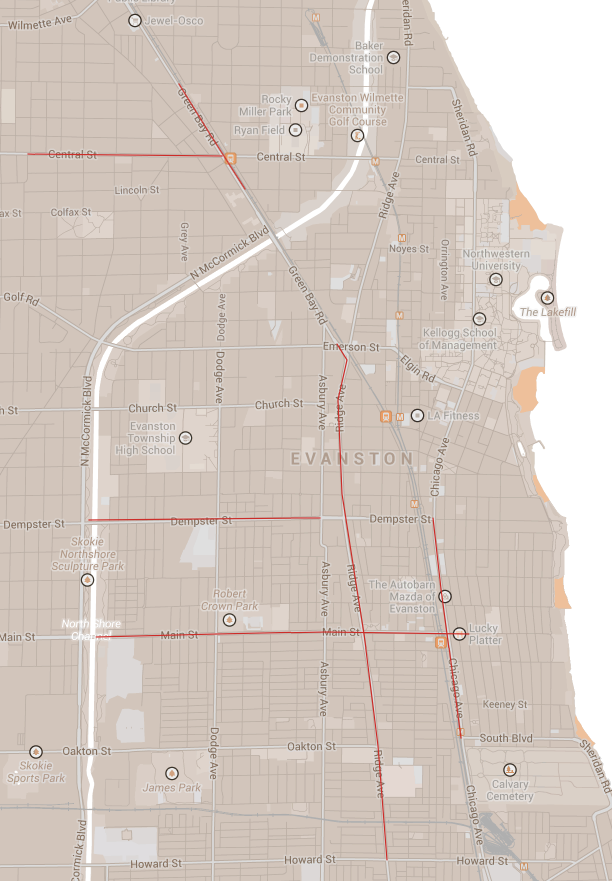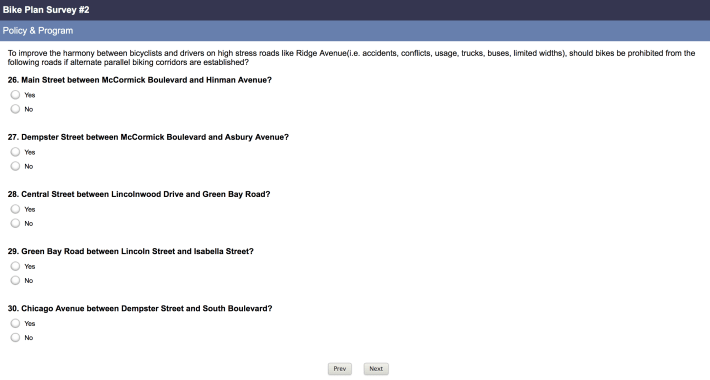A survey to collect resident feedback about the draft Evanston Bike Plan launched yesterday, and some of the questions have alarmed residents and advocates. The survey has several odd questions, beginning with a requirement that respondents complete a quiz about bicycling laws. What truly alarmed respondents like Wheel & Sprocket store manager Eric Krzystofiak, though, is a question asking, "should bikes be prohibited from the following roads if alternate parallel biking corridors are established?"
Krzystofiak rides from his home in Chicago to the bike shop, one block from the Davis Street Metra station. "What's great in Chicago is that you can ride anywhere," he said, so "it seems counterproductive to see roads that cyclists aren't allowed on, when we’re trying to be bicycle friendly in Evanston."
The suggestions were first revealed in a public input session last month, where Public Works director Suzette Robinson said the city wasn't making recommendations but seeking to "increase harmony" among bicyclists, pedestrians, and drivers.
The survey asked respondents to consider banning bicycles on five distinct street segments, without describing where the "alternative parallel bike corridors" would be or what infrastructure, if any, they would have. The five street segments, totaling 4.6 miles, are:
- Main Street, between McCormick Boulevard and Hinman Avenue
- Dempster Street, between McCormick Boulevard and Asbury Avenue
- Central Street, between Lincolnwood Drive and Green Bay Road
- Green Bay Road, between Lincoln Street and Isabella Street
- Chicago Avenue, between Dempster Street and South Boulevard
Ron Burke from the Active Transportation Alliance said that "banning bikes to relieve roadway stress is like banning light bulbs to prevent sunburns." Burke continued, "The survey frames this notion as a possible way to 'improve harmony between motorists and cyclists on high stress roads.' We see that Evanston is already using the most effective strategies to achieve this goal: developing comfortable biking routes that connect key destinations so people don’t need to bike on high stress streets, and using traffic calming measures to make these streets less stressful places where everyone can travel safely."
There are certainly many bicyclists who currently ride on these streets. The small subset of bicyclists who use Strava to track their rides have left virtual tracks upon all of them, notably along Chicago.
Sue Carlson is a 40-year Evanston resident and represents the Citizens for Greener Evanston group on the city's Bike Plan Committee. "I don't think they should be shut out to bikes," Carlson said. She also mentioned that the survey was "hard to comprehend," because "you have to imagine the whole length of the street they list on the survey." The survey lacks a map, and not every resident may be familiar with each detailed segment.
I talked to one Evanston resident, a father who bikes with his young daughter and who asked to remain anonymous, to describe some of these streets. Along Main Street, he said, a business district begins at Hinman Avenue, "lined with coffee shops, restaurants, and outdoor seating. [It's] hardly a speedway." It passes three schools, a community center, a park, and CTA and Metra stations. Chicago Avenue, he said, has space for bike lanes between Dempster and Main, and "while busy, it's still bike-able." Chicago Avenue runs between a row of local businesses and the railroad viaduct carrying both the CTA Purple Line and Metra UP-North line. Banning bikes on both streets would eliminate lawful bike access to the Main station.
Confusingly, documents on the city's website also describe proposed "comfortable corridors" for bikes [PDF], two of which overlap streets where the survey suggests bikes could be banned instead. A "comfortable corridor" along Chicago Avenue could feature a a two-way protected bike lane, or a one-way protected bike lane with a neighborhood greenway on parallel Hinman. A similar situation is proposed for Green Bay Road, where the bike plan appears to offer a choice between banning bikes, or building a protected bike lane in each direction.
Carlson, the Bike Plan Committee member, granted that the improvements are "not low-cost" – the "comfortable corridors" are estimated to cost $250,000 to $350,000 – but that, like other communities, "you can alter how streets are set out and make them less stressful for bikers" without a ban. The survey also proposed specific infrastructure designs for certain streets – again, without illustrations or a map – that offered respondents a choice between removing parking to provide a bikeway or "impacting" trees. "When it's proposed that parking is removed for bike lanes," Carlson said, "that's a political issue."







